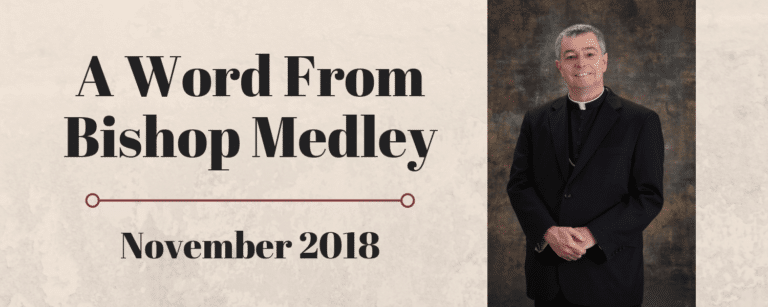The Roman Catholic Church, along with many other Christian denominations, honors all those who “have gone before us marked with the sign of faith” as saints. Our tradition celebrates particular saints with special feast days. There are multiple days that honor Mary, the Mother of God, under special titles. Each of the 12 Apostles is so honored. There are within our Catholic calendar dozens of particular feast days. In our faith and confidence, we assume that there are literally tens of millions of good men, women and children who lived noble and faithful lives and now enjoy the everlasting reward of heaven. Most of their names go unrecorded, their earthly resting places unmarked.
Each year the Church celebrates November 1 as the Solemnity of All Saints and reminds us to celebrate God’s blessings showered upon those now in heaven. It provides a good opportunity for us to reflect upon the people in our lives who have gone before us and for whom we have confidence that they rest with God. This does not require that we believe these good souls lived without sin, but rather that their good works combined with God’s mercy have led to everlasting joy and happiness. Among the greater known saints, they were not without sin and human frailty, save for the Blessed Virgin Mary.
On October 14 this year, Pope Francis presided over the canonization of several new saints. Two of these were figures of great historic importance in the 20th century: St. Pope Paul VI and St. Oscar Romero.
St. Paul VI succeeded St. John XXIII as pope in 1963. It fell to him to continue the Second Vatican Council, which Pope John had convened in 1962, to a successful conclusion in 1965. Paul was born in 1897 and given the name Giovanni Battista Montini. He became a priest, and his remarkable gifts were recognized. He was one of the closest advisors to Pope Pius XII and many considered him a leading candidate to succeed Pius though he was himself not a cardinal at that time, but the cardinals chose the older Angelo Roncalli, who became John XXIII.
St. Paul VI chose to discontinue some of the trappings of the papacy that suggested the splendor of early monarchs. At the end of the council, he gave away the traditional tiara (crown) that popes had worn and donated the monies to care for the poor. He saw this as a renunciation of human glory and power.
Paul walked a thin line among forces in the Church which sought to influence Vatican II. As he had in his priesthood and in his years as the Archbishop of Milan, he demonstrated a great pastoral spirit. He wrote the encyclical “Humane Vitae” in which he extolled the beauty of marriage and the multiple purposes of married love. In this encyclical, he reaffirmed the Church’s teaching that artificial contraception is not morally acceptable.
Paul is closely identified with the reforms of the liturgy identified with Vatican II. He initiated ecumenical dialogues with Eastern Churches and with Protestant Churches. He was the first pope in modern history to travel extensively around the world and in 1964 was the first pope to visit the United States. (I remember this because Catholic school children got the day off from school so that we could watch this on television – there being no television in our school.)
St. Paul VI died on August 6, 1978, the Feast of the Transfiguration of the Lord. He was buried in the lower level of St. Peter’s Basilica near the tomb of St. Peter.
St. Oscar Romero was born in 1917 in El Salvador and ordained to the priesthood in 1942. He was named a bishop in 1970 and was appointed as the Archbishop of San Salvador in 1977. There was some discontent in some quarters about his appointment as he was viewed as very conservative and not expected to speak up for the poor before a repressive government. When a priest friend of his was assassinated for working with the poor, St. Oscar was profoundly impacted and he came to read and understand the Gospel in more radical ways of supporting the poor.
The Catholic Church of El Salvador faced tremendous persecution during Romero’s leadership and he was repeatedly cautioned to not criticize the government or advocate for the poor. On March 23, 1980, Romero delivered a sermon in which he called on Salvadoran soldiers, as Christians, to obey God’s higher order and to stop carrying out the government’s repression and violations of basic human rights. The next day, March 24, 1980, a gunman entered the chapel where he was celebrating Mass and shot him through the heart as he stood at the altar. More than 250,000 people gathered for his funeral. There were immediate calls for his canonization and Pope Francis initiated that process as one of his earliest acts as the new pope in 2013. His feast day will be observed as that of a martyr.
Most Reverend William F. Medley
Diocese of Owensboro
Originally printed in the November 2018 issue of The Western Kentucky Catholic.
Copyright © 2018 Diocese of Owensboro/The Western Kentucky Catholic


